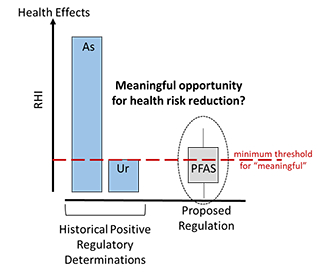College of Engineering News Room
New Paper Questions Meaningfulness of PFAS Drinking Water Regulations
Does regulating per-and polyfluoralkyl substances represent a meaningful
opportunity for health risk reduction?
With governments at all levels setting new policy for clean drinking water, a recently released peer-reviewed analysis provides a method for policymakers to evaluate regulatory levels and assess and compare meaningfulness in terms of protecting public health.
The open access paper, authored by Katherine Alfredo, PhD, assistant professor in civil and environmental engineering at the University of South Florida (USF), and Chad Seidel, PhD and Amlan Ghosh, PhD, of Corona Environmental Consulting, finds that regulatory levels for PFOA and PFOS alone will not achieve a national meaningful health risk reduction compared to previous regulatory determinations. Prior to joining USF Alfredo worked as a Research Program Manager at a large public water utility.

Most people do not know that the U.S. Environmental Protection Agency’s established drinking water contaminant regulations must meet a qualitative “meaningful opportunity” threshold in health risk reduction. However, this leaves quantitative contaminant levels being ruled in the sole judgement of the EPA administrator - which is not a quantitative measure.
In the journal article published by AWWA Water Science, Alfredo and her co-authors use a Relative Health Indicator (RHI) metric to calculate gains in health risk reductions by regulating contaminants at certain thresholds. This metric was originally developed in 2014 as part of a Water Research Foundation project (#4310) and was applied as a regulatory evaluation tool by Alfredo, Seidel, and Ghosh in an earlier 2017 paper. The novelty of the metric is that it creates a single scale upon which all contaminants can be compared. Alfredo and co-authors intend for this scale to help policy makers understand the impact of a regulation and to ensure that health risk reduction and not emotions or media frenzies are driving contaminant levels.

To further highlight the public interest in this topic, a recent episode of John Oliver’s Last Week Tonight show focused on the harmful effects of PFAS on human health, but it did not place it within the context of drinking water regulations. In this most recent paper, they use the metric to evaluate the health risk reduction gained by the new PFAS regulation, potentially helping policy makers form more effective drinking water policy in the future.
Alfredo’s publication is very timely and places her well within the conversation of what will certainly become a national debate over safe drinking water regulations.